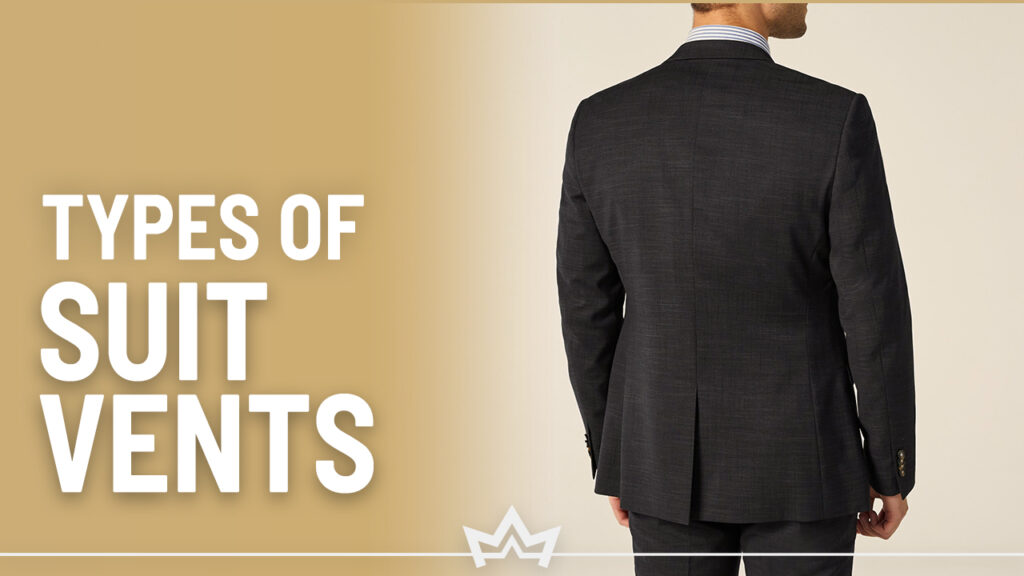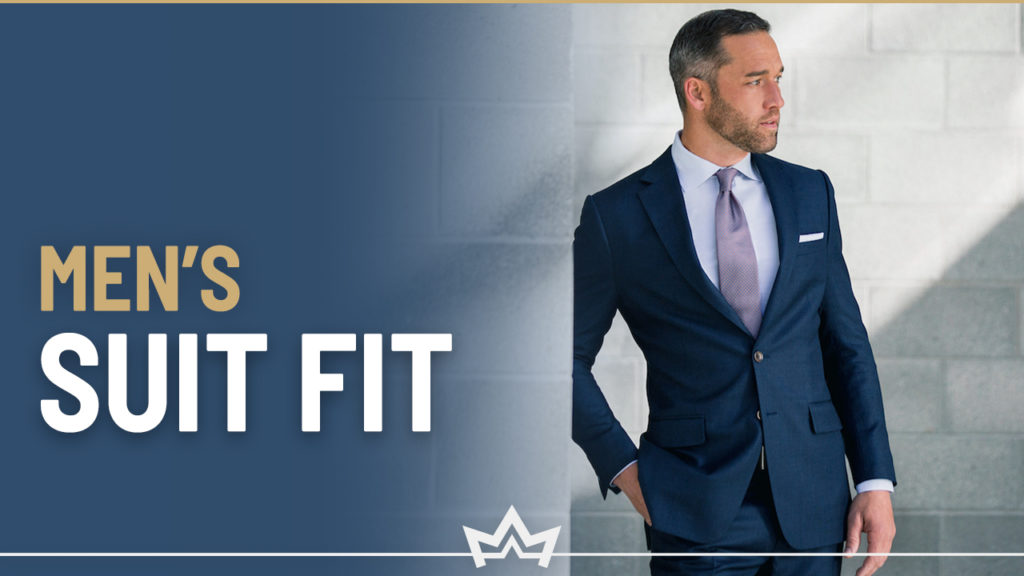Suit jacket vents are a subtle but effective way of influencing the style of your entire suit.
You might not have ever paid much attention to this undervalued part of your suit jacket.
But once you learn more about vents, you won’t see suits the same way.
The effects of your suit jacket’s vents may be the difference between a suit that looks stunning on you and one that looks unbecoming.
Let’s examine the three different types of suit vents, who should wear them, and when.
What are Suit Vents?
Take a look at your suit jacket. Does it have a slit or two on the bottom along the hemline? Those are suit vents.

These openings run lengthwise for a few inches, and their location can vary.
The number of vents on your suit jacket can also fluctuate, significantly impacting the suit style.
You can have either a single vent in the center of the back or two vents on each side.
Or, you can have zero vents, depending on your jacket’s anatomy.
Your suit vents can play a subtle role in determining your suit’s formality and how flattering it may or may not be on you.

Vents allow better movement for your suit jacket.
They were initially introduced so that a man’s jacket didn’t scrunch up and look ugly while riding a horse.
That isn’t an issue for today’s modern world, but the ease of movement is still paramount.
The suit vents allow your jacket to move aside so you can preserve your sleek line and your jacket doesn’t awkwardly puff out.
Single Suit Vent
You may also hear this option referred to as a center vent.
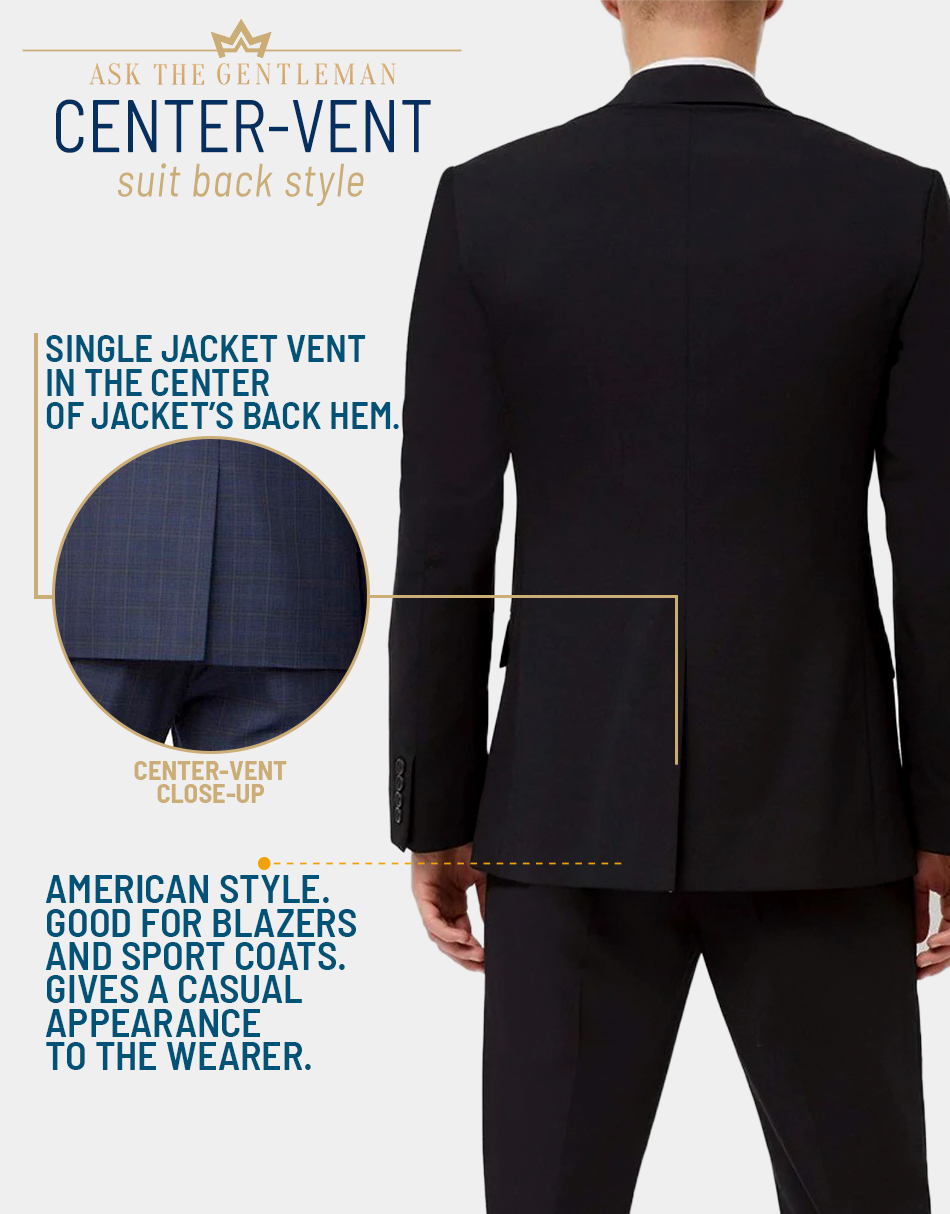
As its name implies, there is only one vent on this jacket.
This type of vent is often found on blazers and sports coats but is versatile enough to be on many suit jackets, too.
Single suit vents are a relatively casual detail. It also happens to be the most common style.
Single vents are widely considered an American style and are found on most off-the-rack suit jackets.
While you can wear a single-vent suit for nearly any occasion, they are most fitting for office work and casual social outings.
There isn’t a particular body type that should avoid this suit style; however, large men should stick to single vents as much as possible.
A single-vent suit jacket is very accommodating for men with oversized rear ends.
An ample backside can protrude against a suit jacket and push it out; a center vent allows the suit jacket to part slightly around the large bottom and makes room for it.
The single suit vent style is widely preferred by older generations of suit wearers, who wore this style their entire work careers when business casual wasn’t a standard option.
Double Vent Suit
This vent style has two side openings along each suit jacket side seam near the back.
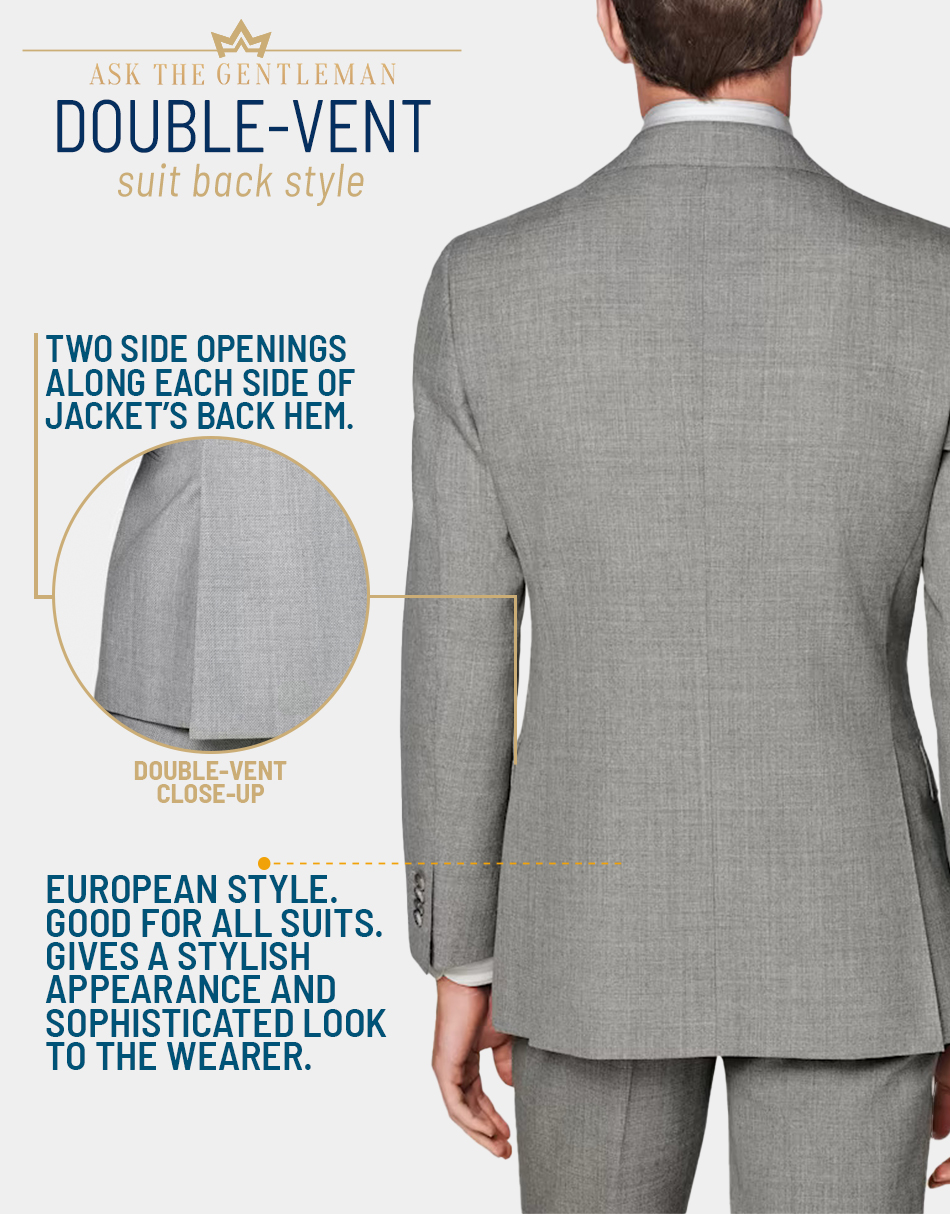
You’ll find this type of suit vent more commonly on high-end or made-to-measure suits.
Double vents aren’t widely found on suits because they’re more costly to make; they require more fabric and take more time to create.
Therefore, an off-the-rack suit is unlikely to incorporate this style.
Mass-produced suit manufacturers favor the easier-to-make and less costly single vent; if you want a double-vented suit, consider visiting your local tailor.
Double-vented jackets are considered a more suave approach to suit wearing and are often considered British style.
They generally appear to drape more gracefully around a man’s waistline.
Double vents on your suit jacket are appropriate to most men’s body types as long as you don’t have a protruding bottom half.
You’ll notice the subtly elegant outline this fashion creates.
Double vents on your suit jacket will set you apart from most other men because this style tends to be somewhat exclusive since it’s typically a bespoke feature.
No Vent Suit
The final option for your suit vent is to go ventless.
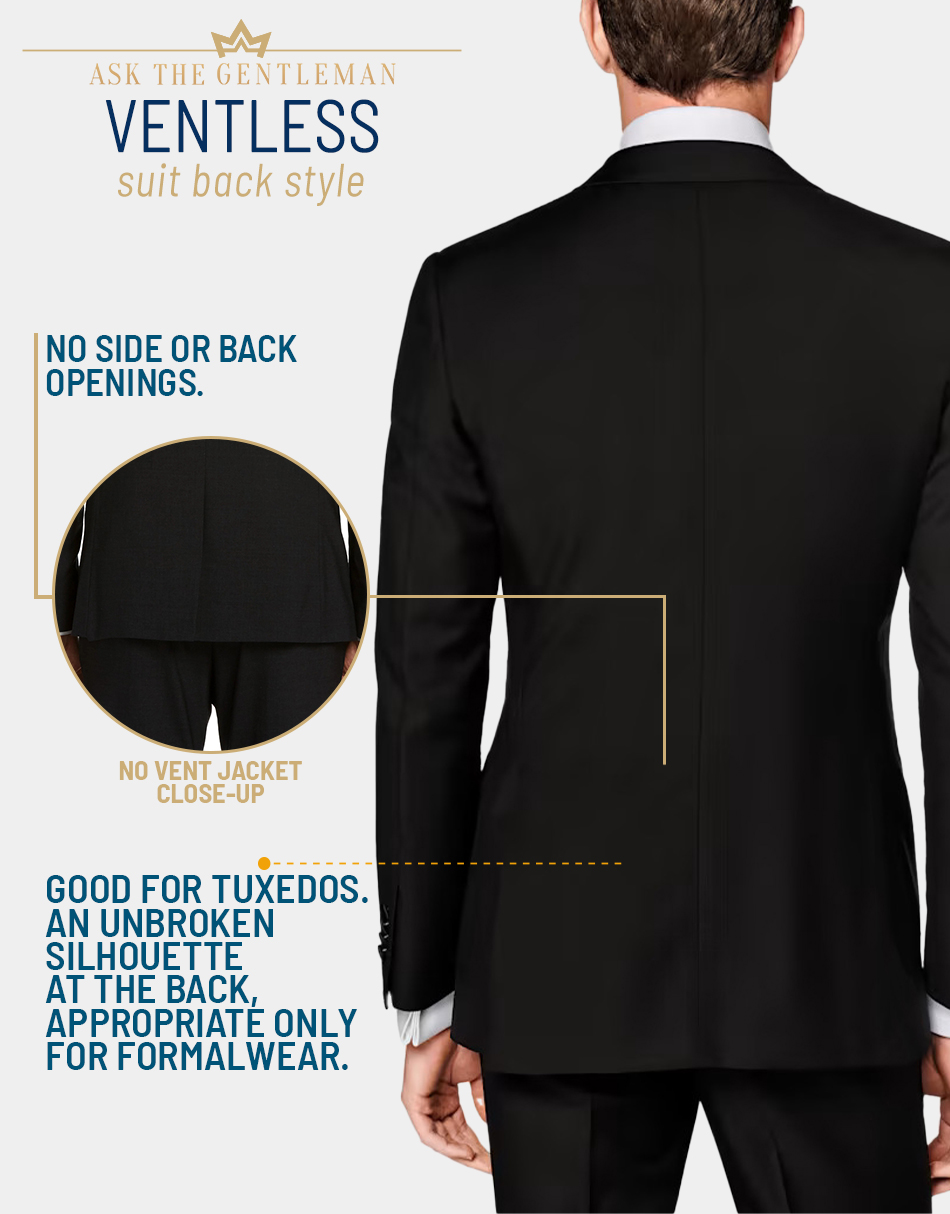
An unvented suit jacket is the most formal option and is typically only appropriate on tuxedo jackets.
It is suitable to wear a no-vent suit in some settings that don’t have a formal dress code requirement.
But be aware that choosing this type of suit jacket will probably draw some attention.
Skipping vents on your suit jacket gives its wearer an incredibly sleek and streamlined figure.
A no-vent jacket looks best on smaller, more petite men because the suit jacket is tighter thanks to its lack of openings.
It also provides a slimming and elongating look.
The main drawback to having no vents on your suit jacket is that you aren’t able to move as freely as with a suit with vents.
And definitely don’t put your hands in your trouser pockets when you don’t have jacket vents! You’ll destroy your entire sleek aesthetic.
Which Suit Vent Should You Choose?
There are several considerations worth making when deciding which vent style your should choose for your suit.
First of all, take a look at your body type. For example, do you have a very large derriere?
To put it bluntly, an oversized butt will make your suit jacket hem extend in an unsightly manner.
The only option for this body type is a single-vent suit.
On the other hand, petite or short men look best in a ventless suit jacket.
The lack of suit vents creates a lengthening appearance because there is nothing to break up the sightline.
Still, most men can wear a double-vent suit jacket.
You must also factor in how you’ll be wearing the suit.
If your event is a black tie affair, you’ll need a suit jacket with no vent.
Of course, on the opposite end of the spectrum, a single vent is probably all you’ll need if you’re buying a suit to wear to work regularly.
Center Vent vs. Side Vents Formality Difference
A suit jacket with a center vent is decidedly more casual than a double-vented one.
However, that alone doesn’t determine the formality of the entire suit; it’s only one small detail.
Other significant contributions to your suit’s formality are the suit’s lapel and the jacket’s pocket style.

Double vented suits top single vents in formality because they can move more freely while still maintaining their sleek aesthetic.
It’s difficult to cause a double vent suit jacket to create that unsightly bunch-up you get with other styles.
A double vent suit makes a stronger statement, so consider this style the finest option for a semi-formal occasion.
They are also flattering on most body types, so most men can easily sport the look.
However, a single-vent suit jacket can be highly flattering on a suit that’s beautifully tailored.
That said, it impairs the impression of a smooth, continuous line from behind.
Choosing the right suit jacket vent can mean the difference between having a suit that flatters and having a suit that makes you look shabby.
Why is the Suit Jacket Vent Important
Vent styles are about more than just looks and movement but personal taste.
Do you feel more comfortable with the tried and true approach to suiting up, wearing what most other men are wearing?
If so, you are better off with a center vent suit jacket.
There is nothing wrong with that choice. Your comfort level is vital to looking good since it greatly affects your confidence.
On the other hand, if you like to dabble on the edges of more trendy and European ways of dressing, you should add a few side vent suits to your wardrobe.
Having multiple ways of adding vents (or not) to your suit jacket gives you freedom of choice.
You get to decide your style and how comfortable you need your movement to be.
Also, you can choose based on what type looks most flattering and whether you want to blend in or stand out.

